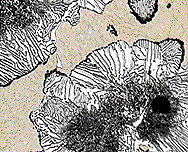|
Metallography

Objective:
To develop an understanding of the principles of practical metallography and the examination of some typical
microstructures. Note: You will NOT be writing a lab report for this lab.
Your lab notebook WILL be graded on the items in bold below:
Procedure:
Examine the specimens at different magnifications. Start with low power
examination to obtain an overall picture. Then, at successively higher
magnifications, resolve the fine detail. Draw a neat sketch of each
specimen you examined at any suitable magnification. The sketch should
include the magnification used.
Answer the following questions in your lab notebook PRIOR to coming to lab
(this is part of the Pre-lab):
- What
is the significance of microstructure in the material properties?
- Give
examples of some microstructure-dependent material properties.
- What
are the important steps metallographic sample
preparation?
|
|
SPECIMEN NO.
|
TYPE OF STRUCTURE
|
|
1)
|
X1
|
Pure Metal: Pure zinc, sand cast
|
|
2)
|
XlA
|
Impure Metal: Impure zinc, sand cast
|
|
3)
|
X2
|
Solid solution: Copper/4% Tin alloy, sand cast
|
|
4)
|
X5
|
Eutectic Type: Cu/8.4% P, eutectic alloy, sand cast
|
|
5)
|
X6
|
Hypoeutectic alloy: Cu/4.5% P, sand cast
|
|
6)
|
X9
|
Peritectic tvpe
structure: Sn/10% Sb alloy, sand cast
|
|
7)
|
X10
|
Widmanstatten structure: Cu
58/ Zn 42, sand cast
|
|
8)
|
X17
|
Eutectoid reaction: 0.8 %C steel, 1 hr at 800 degrees C,
furnace cooled (fully annealed)
|
|
9)
|
X18
|
Eutectoid reaction: 0.8% C steel, 1 hr at 800 degrees C,
cooled in still air (normalized)
|
|
10)
|
X19
|
Hypoeutectoid steel: 0.35% C
steel bar, furnace cooled from 870 degrees C.
|
|
11)
|
X20
|
Hvpereutectoid steel: 1.3% C
steel bar, furnace cooled from 970 degrees C
|
|
12)
|
X25
|
Martensite: 0.35% C steel,
water-quenched from 875 degrees C
|
Note: Specimens 8-12 will require the use of the oil immersion
lens. Use the oil with the oil immersion lens only.
If the microstructure of a sample is not visible or the sample is bad,
exchange the sample with one that is viewable. If a suitable sample is not found,
ask the T.A. to assist you in polishing and etching the sample so that the
microstructure is visible.
Before leaving the lab, have your T. A. examine and grade your lab
notebook.
 Go Back
to Materials Science Main Page Go Back
to Materials Science Main Page
|
